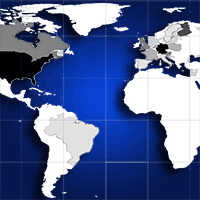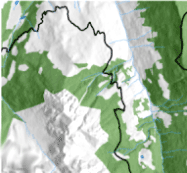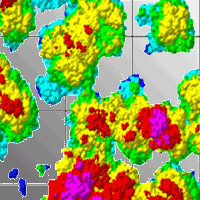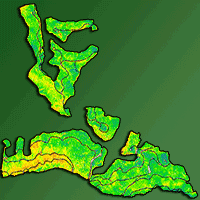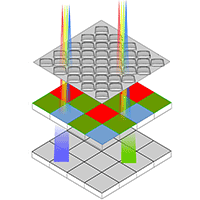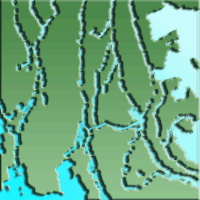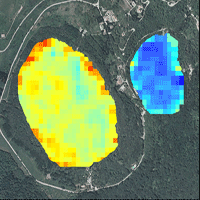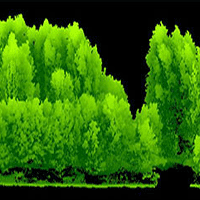
Remote sensing of american maple in alluvial forests: a case study in an island complex of the Loire valley (France)
Hilaire Martin (1) , Jean-Matthieu Monnet (2), Marie De Boisvilliers (3), Richard Chevalier (1), Marc Villar (4)
iForest - Biogeosciences and Forestry, Volume 13, Issue 5, Pages 409-416 (2020)
doi: https://doi.org/10.3832/ifor3237-013
Published: Sep 16, 2020 - Copyright © 2020 SISEF
Technical Reports
Abstract
Due to their particular topographic position between land and river, riparian forests are ecosystems rich in biodiversity. In France, along the Middle Loire (from Nevers to Angers), Black poplar (Populus nigra L.) forests are often in mixtures with the American maple (Acer negundo L.), introduced into the country in the 18th century. We tested the detectability of American maple by LiDAR and very high-resolution multispectral imagery on an island complex. We found that coupling the point cloud height standard deviation with a vegetation index in the red, green and blue spectrums discriminated American maple with a success rate of more than 90%.
Keywords
Acer negundo, American Maple, Box Elder, Populus nigra, Black Poplar, Airborne Laser Scanning, Remote Sensing, Exogenous Woody Species, Loire River
Authors’ Info
Authors’ address
Richard Chevalier
INRAE Val de Loire, Site de Nogent-sur-Vernisson, Domaine des Barres 45290 Nogent-sur-Vernisson (France)
Univ. Grenoble Alpes, INRAE, UR LESSEM, F-38402 St-Martin-d’Hères (France)
L’AVION JAUNE, 1 chemin du Fescau, 34980 Montferrier-sur-Lez (France)
INRAE Val de Loire, UMR 0588 INRA-ONF BioForA, 2163 Av. de la Pomme de Pin, CS 40001 Ardon, 45075 Orléans Cedex 2 (France)
Corresponding author
Paper Info
Citation
Martin H, Monnet J-M, De Boisvilliers M, Chevalier R, Villar M (2020). Remote sensing of american maple in alluvial forests: a case study in an island complex of the Loire valley (France). iForest 13: 409-416. - doi: 10.3832/ifor3237-013
Academic Editor
Matteo Garbarino
Paper history
Received: Sep 13, 2019
Accepted: Jul 08, 2020
First online: Sep 16, 2020
Publication Date: Oct 31, 2020
Publication Time: 2.33 months
Copyright Information
© SISEF - The Italian Society of Silviculture and Forest Ecology 2020
Open Access
This article is distributed under the terms of the Creative Commons Attribution-Non Commercial 4.0 International (https://creativecommons.org/licenses/by-nc/4.0/), which permits unrestricted use, distribution, and reproduction in any medium, provided you give appropriate credit to the original author(s) and the source, provide a link to the Creative Commons license, and indicate if changes were made.
Web Metrics
Breakdown by View Type
Article Usage
Total Article Views: 39366
(from publication date up to now)
Breakdown by View Type
HTML Page Views: 33093
Abstract Page Views: 2857
PDF Downloads: 2597
Citation/Reference Downloads: 0
XML Downloads: 819
Web Metrics
Days since publication: 1934
Overall contacts: 39366
Avg. contacts per week: 142.48
Citation Metrics
Article Citations
Article citations are based on data periodically collected from the Clarivate Web of Science web site
(last update: Mar 2025)
Total number of cites (since 2020): 1
Average cites per year: 0.17
Publication Metrics
by Dimensions ©
Articles citing this article
List of the papers citing this article based on CrossRef Cited-by.
References
Système d’Information des Évolutions du Lit de la Loire et de ses affluents. Typologie des habitats du SIEL 2. Guide de terrain et de lecture pour la cartographie [Information System of the Evolutions of the Loire riverbed and its tributaries. SIEL Habitat Typology 2. Field and Reading Guide for Mapping]. Conservatoire National du Bassin Parisien, délégation Centre-Val de Loire, Orléans, France, pp. 1-27. [in French]
Gscholar
Recursive feature elimination and random forest classification of Natura 2000 grasslands in lowland river valleys of Poland based on airborne hyperspectral and LiDAR data fusion. Remote Sensing 12: 1-33.
CrossRef | Gscholar
Que savons-nous de l’Erable négondo (Acer negundo L., 1753)? [What do we know about American maple (Acer negundo L., 1753)?]. Naturae (10): 257-283.
Gscholar
On the use of unmanned aerial systems for environmental monitoring. Remote Sensing 10: 1-33.
CrossRef | Gscholar
Classification on riparian forest species and health condition using muti-temporal and hyperspatial imagery from unmanned aerial system. Environmental Monitoring and Assessment 188 (146): 1-19.
Gscholar
Tree top detection using local maxima filtering: a parameter sensitivity analysis. In: Proceedings of “Silvilaser 2010 - 10th International Conference on LIDAR Applications for Assessing Forest Ecosystems”. Freiburg (Germany) 14 Sep 2010, pp. 9.
Online | Gscholar
Caractérisation des forêts de montagne par scanner laser aéroporté: estimation de paramètres de peuplement par régression SVM et apprentissage non supervisé pour la détection de sommets [Using airborne laser scanning for mountain forests mapping: Support vector regression for stands parameters estimation and unsupervised training for treetop detection]. PhD thesis, Grenoble Images Parole Signal Automatique Department, Université de Grenoble Alpes, France, pp. 187.
Online | Gscholar
Riparia: ecology, conservation, and management of streamside communities. Elsevier Academic Press, London, UK, pp. 418.
Gscholar
Monitoring vegetation systems in the great plains with ERTS. In: Proceeding of the “3rd ERTS Symposium”. Washington (DC, USA) 10-14 Dec 1973. NASA SP-351 1, US Government Printing Office, Washington, DC, USA, pp. 309-317.
Gscholar

